潤日Run Ri - Escaping from China to Japan
Guest contribution by Masutomo Takehiro on the new wave of Chinese immigration to Japan: they come to pursue high quality and unrestricted lifestyle, and force change in Japanese society and politics
Japan has become an immigration superpower. Over the past 18 months, every day approximately 1,200 non-Japanese received a work or residence visa; the total number of non-Japanese residents have shot up from a little more than half-a-million when I arrived here in 1986 to 3.5 million now. Approximately one-third of the total and new arrivals are Chinese nationals, and the numbers have been accelerating since the Shanghai lockdown in 2022. That’s when the term 潤日 Run Ri became popular in China — Escape to Japan.
For the Chinese escapees, Japan offers a very cost effective, high quality and unrestricted lifestyle. They bring clear economic benefits, but pose clear challenges to a very proud local culture. For Japanese society and politics, immigration is poised to become the next big topic, possibly even splitting the LDP.
I am proud to present you with my friend, Professor Masutomo Takehiro. Earlier this year he published the bestselling book 潤日 Run Ri. It’s Japanese language only (a Chinese language version is in the making, published in Taiwan….if anyone knows of an English langue publisher, please let us know….); so I am very glad he agreed to sharing with Japan Optimist readers his calm and in-depth analysis of this new wave of Chinese immigrants in English (he is quadrilingual, most importantly fluent in Chinese having worked as a journalist writing in Chinese for Caixin Media in Beijing (see bio below).
I trust you’ll find his views on the political and social dynamics forced by this immigration rush to Japan stimulating. Shout out to Duncan Clark and Hidaka Sawako for helping to put it all together….enjoy; and as always, comments welcome — many cheers ;-j
潤日Run Ri - Escaping from China to Japan
By Takehiro Masutomo
When I started writing my book back in 2023, I believed this very topic—how to address the influx of a new type of Chinese immigrant—deserved national-level discussion. But back then, few seemed to care.
Now things have changed. Since early 2025, the new wave of Chinese immigration to Japan has been covered almost daily in the media, mostly sensationally. Just this week a major weekly magazine carried this cover story: New Chinese immigrants — Run Ri 潤日. More importantly, politicians have begun to express serious concerns.
Before getting too excited, let’s do a reality check. The number of Chinese people living in Japan is projected to hit one million in 2026. And the new immigrants I focus on – the so-called Run- People – are estimated to be a bit less than100,000; i.e. approximately 10% of the total number of Chinese nationals resident in Japan. Still, their impact on society goes far beyond a mere number.
The title of my book is Run Ri / 潤日. The Chinese character “潤” (pronounced rùn) originally meant moisture or prosper. But this term sounds like ‘Run’ in English, so this word started to symbolize “emigration” or “escape.” Since 2022 – following the Shanghai lockdown - this term has become popular among Chinese to describe citizens seeking a better life abroad.
The first character — 潤 Run — describes a global phenomenon. Tens of thousands of Chinese nationals are immigrating to countries like Singapore, Thailand, Canada, Australia and the US every year. According to the Henley Private Wealth Migration Report 2024, 15,200 High Net-worth Individuals (people with investable assets of more than US$1million) are estimated to leave China in 2024. This makes China the country with the largest out-flows of wealthy individuals in the world. The second character日 (Ri) of course means Japan. Putting the two characters together, the title Run Ri means new Chinese immigrants escaping to Japan.
Faced with worsening economic and political situations, these individuals seek to
secure their assets
obtain better educational opportunities for their children
enjoy freedom of speech/expression
In a turbulent world, Japan is increasingly becoming the country of choice for those seeking stability.
Why Chinese are choosing Japan
There are several reasons for choosing Japan. Living costs are low. (白菜价 cabbage price…)
Geographically, Japan is close to China. Their first choice was the U,S, but the situation in the U,S, has worsened significantly, with anti-Chinese sentiment rising and anti-Asia hate crimes frequently in the news. In fact, some Chinese are now leaving the US for Japan, doing a so-called 二潤 (Er Run), or “second run”.
Importantly, it’s very easy to get a visa for Japan. While most other developed countries have been tightening investor visa programs, Japan has by contrast relaxed its visa requirements. For as little as \5 million (less than US$40,000) foreigners can set up a Japanese company and then qualify for an investor or business manager residency. By visa category “Business Manager” or “Highly-Skilled Professional” are the most frequently used ones.
Language is also not a serious obstacle. The Japanese use Kanji, Chinese characters, so Chinese people don’t need to learn Japanese from scratch for daily life. Many of these newcomers are familiar with Japanese culture, having been to Japan as tourists or grown up reading manga or watching anime and Japanese TV shows or films.
More importantly, they very much appreciate Japan’s low-cost and very robust social welfare- and reliable healthcare systems, as well as Japan’s excellent, open and extremely cost-efficient education system.
How are the new Run Ri people different from the old immigrants from China?
Here is my hypothesis. The new Run Ri people typically have a more global perspective. Old immigrants were often from coastal regions like Fujian or the Northeast Region, but many new immigrants come from big cities like Shanghai and Beijing.
Old immigrants were typically trainees and students, living in rural areas or areas like Ikebukuro, and more recently Nishikawaguchi. New immigrants tend to live in central Tokyo, including high-rise buildings around the Tokyo Bay Area.
These new immigrants are often upper-middle class, by profession, they could be entrepreneurs, academics, media professionals, intellectuals and cultural figures. New immigrants often have a comfortable amount of assets at home, easily more than US$ 1 million. They enjoy a very good lifestyle here in Japan right from when they get here.
In sharp contrast, most of the older generation immigrants started out by living in “survival mode”. They came to Japan in their 20s to to study or to earn money through their hard labor. The new ones come having made their fortunes in China first, now escaping to Japan to grow their capital and to enjoy the cheap and non-intrusive Japan good lifestyle.
Importantly, unlike the older generations of immigrants, many new immigrants can’t speak Japanese. They are in their mid- to late 30s or older— perhaps a bit late for language acquisition. They also tend to come to Japan as a family, together with their kids, rather than the old generation where typically the man came first as an entry-level trainee or student.
Sometimes the Run Ri are more inclined to be critical or even anti-government. It makes sense because by definition they “escaped" from China. The older generation who entered as trainees or students always had an eye on perhaps going back to China after their training and/or initial career.
Tokyo first….
Data suggests most new immigrants chose to live in Tokyo. My hunch is that more than 50% of new immigrants live in Tokyo. And the number of Chinese residents living in central, core districts is clearly on the upward trend. Bunkyo-ku is getting very popular. There are lots of high rise apartments in this area. This graph doesn’t show but actually the ward with most Chinese residents is no longer Shinjuku-ku, but Koto-ku. Toyosu — the re-claimed land area just outside Ginza hosts not just the new Tokyo Fishmarket but is full of new high-rise “tower mansion” condominiums extremely popular with Chinese buyers. Toyosu is part of Koto-ku.
We can observe a similar pattern in Osaka. But the total population is not growing as fast. By ward, Chuo-ku is accelerating. That’s also where many new high-rise apartments are located.
Under Japan’s National Strategic Special Zones system, short-term rentals — what they often call minpaku — can be operated year-round in Osaka. Interestingly, there is an estimate that over 40% of these units are managed by Chinese nationals. In practice, this has become a pathway for some to obtain a business manager visa.
Social Impact – lop-sided internationalization of the education system
Japan now almost functions as a ‘second school district’ for Chinese people. This is because Japan faces a depopulation issue while in mainland China, exam wars are intensifying.
In Takadanobaba — between Shinjuku and Ikebukuro and close to the elite university Waseda —you can see many Chinese cram schools. In major prep schools, the ratio of Chinese students to the total is rising. Up to 25% in some SAPIX branches. In Bunkyo-ku, there are prestigious public elementary schools, called 3S1K, many Chinese immigrants move there so their kids can go to one of these schools. I learned in some grades over 10% of students were Chinese. Some locals now consider leaving the area because there are too many Chinese newcomers.
In Tokyo, Chinese parents queue for top international schools. If you open one, it will be 100% Chinese. For the established schools, the China percentage can now be as high as 30%.
Some Japanese universities started to offer classes in Chinese. Some private high schools in remote areas began to accept Chinese students — up to 50% in terms of the ratio. The number of Chinese students in top graduate schools like Waseda, University of Tokyo, nearly doubled over the past several years. Diversity of non-Japan students is now a serious challenge, as not many Indian students chose to come to Japan (with U.S. and U.K. universities a clear preference).
Cultural impact
They deeply engage in cultural and intellectual activities. Noticeably, Chinese language bookstores opened in Tokyo one after another in recent years. They are called “independent bookstores” in Chinese, 独立書店.
Each shop owner picks a certain theme. These bookstores host events regularly. In this sense, they are creating space for intellectual exchange for the newly-arrived immigrants. This shows how Chinese intellectuals are concentrated in Tokyo and are networking in real life (not just social media chatrooms).
In addition, in the creative industry, musicians, live house owners, documentary filmmakers, and even comedians are flocking to Tokyo.
To accommodate rich Chinese newcomers, of course, we see more high-end Chinese restaurants opening in Tokyo. We now have many more Huisuo/会所 or private clubs catering to Chinese across Japan. Like elsewhere, the Chinese super- rich immigrants want to remain low key, so they badly need private space.
Economic impact
On the real estate front, again, the Tokyo Bay Area is hugely popular. But the super-rich prefer low-rise condominiums in the ‘3A’ area — Azabu, Akasaka & Aoyama.
There’s no doubt that Japanese developers have begun targeting foreign buyers. According to a recent private survey, 20% to 40% of newly built condominiums in central Tokyo are now being sold to foreigners.
But they are not necessarily satisfied with the size of Tokyo apartments. They think the flats are too small. As a result Chinese companies are now building their own apartments and houses in suburban areas or in regional cities. Japanese developers are also changing apartment design, like setting up more bathrooms for instance.
How do Chinese pay for luxury properties, when they are limited in theory to US$50,000 a year in remittances outside China? I visited a few underground banks. When they buy real estate, they often use these banks. The Chinese government has tightened regulations on international money transfers. But money laundering is a big concern. It’s already a headache for the Singaporean government. Underground banks and informal remittance networks are thriving, de-facto bypassing Japan’s banking and payments systems. Of course, Japanese financial institutions do wantthis business. In fact one of the mega banks recently contacted me after having read my book to get some more insights and advise on the financial services needs the Run Ri might have….
China money is also coming into Japan, including investments in Japanese stocks. Chinese buyers are also courting Japanese companies. They have their eyes on sectors like J-league teams, for instance, as well as sake breweries, whiskey distilleries, hospitals, cosmetic surgery clinics, educational institutions etc. – you name it, Chinese buyers are keen to invest.
Political impact
Tokyo is increasingly becoming a hub for intellectual exchange among Chinese people. Now there are so many academic seminars, full of Chinese audience, almost every weekend. This is a natural consequence because free space is getting smaller and smaller, say, in Beijing and Hong Kong. Is Tokyo developing into a potential hotbed for China critics and dissidents.
Interestingly, the former Japanese Ambassador to Beijing, Tarumi Hideo, has been openly inviting Chinese intellectuals to Japan since 2010. So at least indirectly, the Japanese government helped form this community. Some say the situation is a bit similar to the late Qing period. Back then, prominent intellectuals like Sun Yat-Sen 孙中山 / 孫文 and Liang Qichao 梁启超 / 梁啓超 lived in Tokyo. (the former spent time in Tokyo in the years leading up to the 1911 revolution which he led to overthrow the Qing dynasty; the latter lived in Tokyo for over a decade since 1898 and also left after the Qing Empire was overthrown in 1911).
Sun Yat-sen argued that the Meiji Restoration could serve as a model for the Chinese revolution. Perhaps more fitting for today’s Run Ri realities, he also said: “Overseas Chinese are the mother of the revolution”.
Could there be a second Sun Yat-sen?
Personally, I think here we need to watch for possible synergies between the rich Run Ri and the intellectual Run Ri. If they were to combine forces and find a common cause, it could get interesting. But I am certain that even the slightest movement in this direction would trigger a more serious response by Chinese authorities, in, one way or another, directly or, more likely indirectly, using others’ hands perhaps.
Meanwhile, on the frontiers of domestic politics here in Japan, there are now some Chinese-born people aspiring to become Japanese politicians. There appears to be a naturalized Chinese person in Kyushu who was elected to the local parliament, as well as some soon-to-be-naturalized already openly declaring rural political ambitions. Faced with depopulation in rural areas, this is a natural consequence.
Japanese public response
To put it bluntly, the survey result shows that most Japanese people are not welcoming towards more Chinese immigrants.
This is a survey from last year, so now with everyone noticing real estate prices skyrocketing and the University of Tokyo is crowded with Chinese students it is becoming more and more visible that there are deeper and more important problems bubbling up aside from the “over-tourism” debate. All indications are that the national sentiment has clearly worsened since the start of this year.
However, as the saying goes, one person's loss is another's gain. While some feel left behind, others see new opportunities. Developers, schools, and financial institutions are finding new demand, eyeing Run Ri money. Chinese people love buying things in Japan, whether modern art or luxury cars — Toyota’s Alphard luxury van is the transport of choice and a must-have status symbol at minimum. Some economists argue that Run Ri capital and business acumen will enhance Japanese competitiveness, and become a catalyst to revitalize the Japanese economy.
Due to poor working conditions in China, Chinese engineers have been flocking to Japan. Currently, around 10% of the jobs held by Chinese residents in Japan are in IT. In the startup community, Chinese talent is increasingly influential, and Chinese AI companies are quietly making inroads. This trend has been compared to the so-called ‘Singapore-washing’ phenomenon. Although it is hard to imagine Chinese executives taking top positions in Japan’s leading companies in the near term, it is likely only a matter of time before Chinese elites will emerge in Japan’s business world.
A first political test – the July Upper House elections
The key upper house elections are approaching, and politicians are becoming increasingly vocal about these Chinese newcomers. Last month, the LDP launched a special committee; and now the most popular opposition party, Democratic Party for the People DPFP, frequently raises related concerns.
Some concrete policy options are under discussion. The first is to stop easing requirements for long-term visas, especially business manager visas. The requirement of \ 5 million is viewed as too cheap an “entrance fee”. Another possibility is to introduce regulations on the sale of land and housing to foreigners. Right now, there is basically no barrier.
Under the WTO’s General Agreement on Trade in Services (GATS), Japan is obliged to provide national treatment, meaning it cannot discriminate between Japanese and foreign nationals. Notably, Japan did not reserve the right to restrict land acquisition by foreigners, unlike some other countries.
Some members of the Democratic Party for the People appear to support expanding the list of areas where land purchases by foreigners can be regulated.
The newly established conservative Japan Conservative Party has argued that, based on reciprocity, if a country like China does not allow land purchases by foreigners including Japanese, then nationals from such countries should not be allowed to buy land, buildings, or condominiums in Japan either.
Another concern is that if casinos are established in Osaka, money laundering might become more prevalent. There is significant potential for Chinese scam centers — which are expanding in Southeast Asia — to also enter the Japanese market, and they have probably already arrived in Japan.
The change in the political landscape after the Upper House election will no doubt have an impact on immigration policy.
Broadly speaking, there appear to be three main groups. The Liberal Democratic Party is relatively moderate but leans slightly conservative. In contrast, the conservative opposition—including parties like the Democratic Party For the People—takes a strict stance on these issues, while the left-wing opposition, including the Constitutional Democratic Party (CDP), is more accommodating toward foreigners.
Should the LDP integrate the Constitutional Democratic Party, the pace of regulatory tightening on immigration and immigrant rules might slow down; however if the conservative opposition comes to power then rules and regulations might be implemented more quickly.
Personally, my top recommendation is for more transparency, to deepen the research on foreigners in Japan. The lack of data on real estate, for example, is a problem. In response, the Ministry of Land, Infrastructure, Transport and Tourism is set to launch its first survey on foreign real estate investments. Similar efforts for transparency and data collection should be stepped-up in education, employment, health care etc. Immigration is always at risk of becoming an emotional social- and political issue. Without facts, evidence-based policy making will become more and more difficult.
Summary
The newly arrived population coming to China from Japan is very distinct from those who proceeded them, especially since 2022. Faced with a worsening economic outlook at home and uncertain prospects, these people are seeking to secure their assets, access better education opportunities, and enjoy freedom of speech. They like to live in city centers, especially Tokyo. Their impact is bigger than one can imagine. As the Japanese public is becoming more frustrated, we may eventually see policy adjustments.
Thank you.
All analysis and opinions are by the author, Masutomo Takehiro.
Link to our discussion at Asia Society Tokyo June 3, 2025
Run Ri Session
Biography :
Takehiro Masutomo is a quadrilingual journalist and adjunct professor at Waseda University, Institute of Japan in the Global Economy. He is the author of the bestselling book Run Ri: Tracing the Footsteps of Chinese Elites Escaping to Japan; published in January 2025 (Japanese language). Takehiro holds a Master’s degree in International Relations from the University of California, San Diego (UCSD). After joining Caixin Media in 2010, he covered international news, with a primary focus on Japan. From 2014 to 2016, he served as a research associate at the Lee Kuan Yew School of Public Policy at the National University of Singapore (NUS). Since 2022, he has provided commentary on Asian affairs for NHK Radio’s news program My Asa! In 2023, he launched the podcast Asia Frontline. His articles have been published in Weekly Toyo Keizai, Nishinippon Shimbun, NewsPicks, Nikkei Asia, The Japan Times, South China Morning Post, The Straits Times, The Jakarta Post, Kompas, Tempo, and many others.







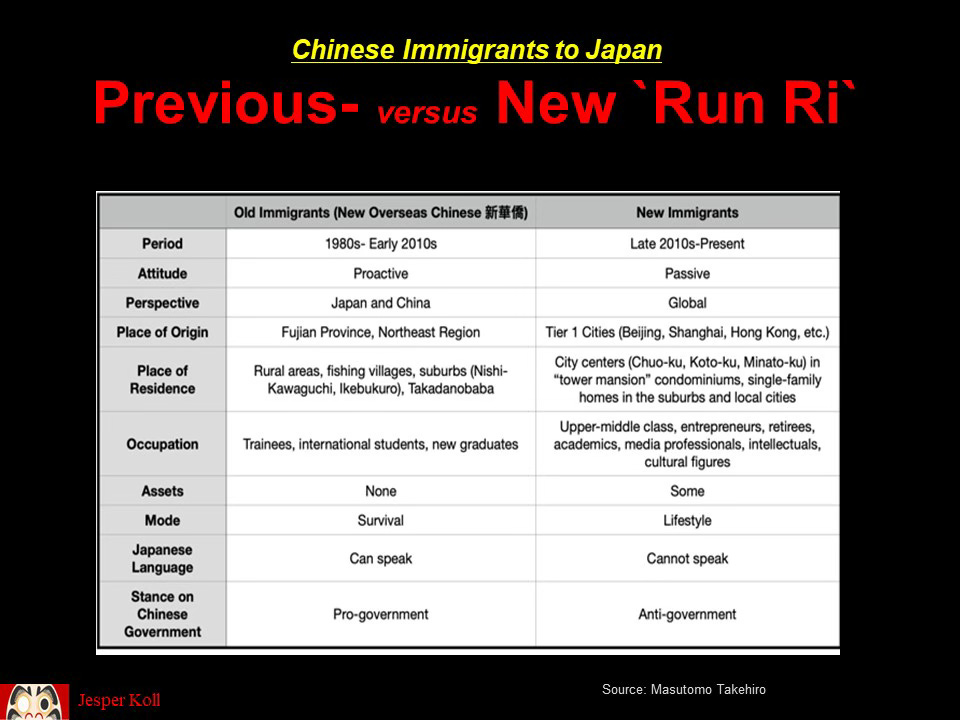



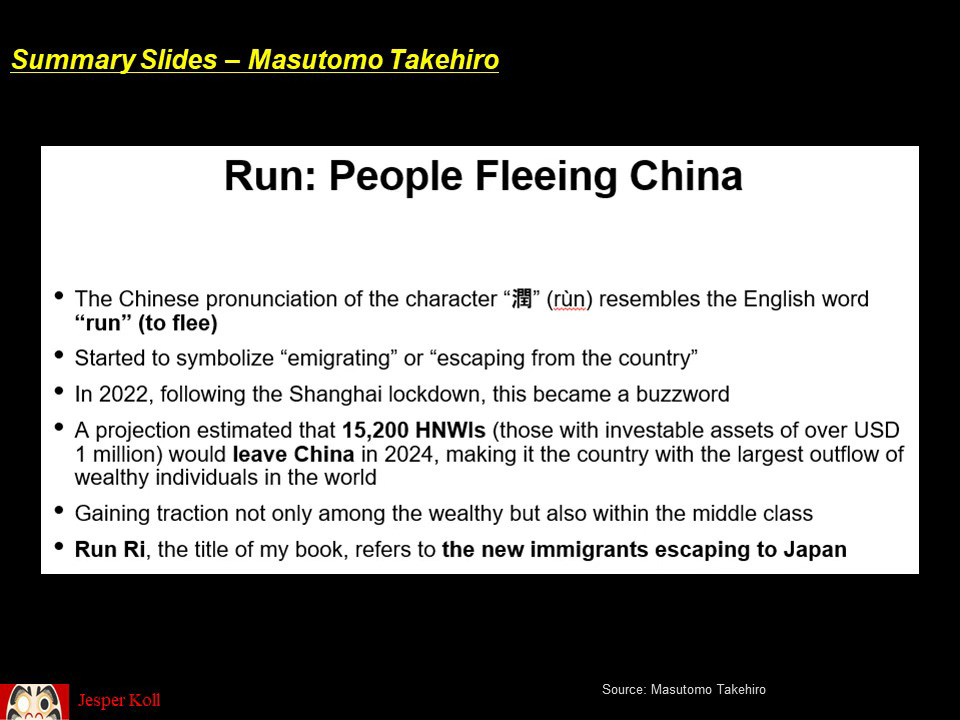


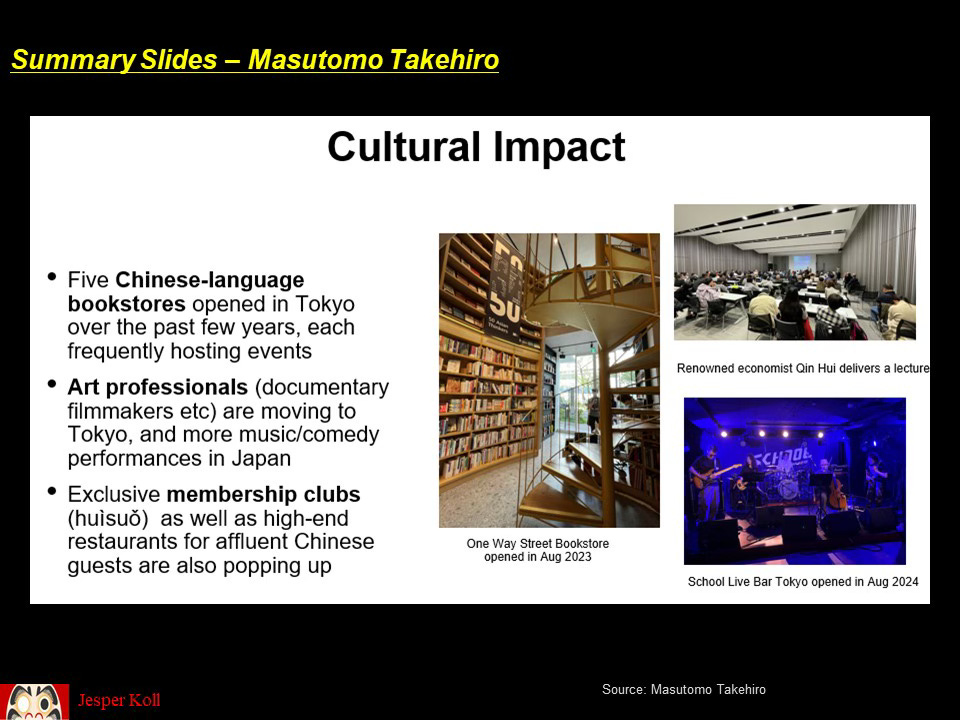
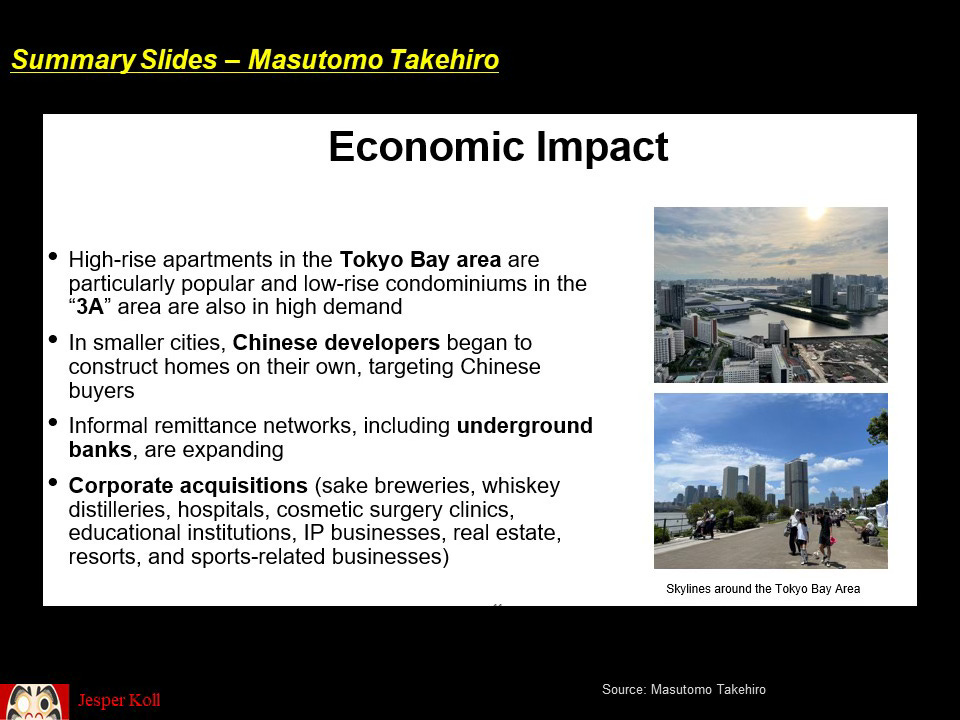
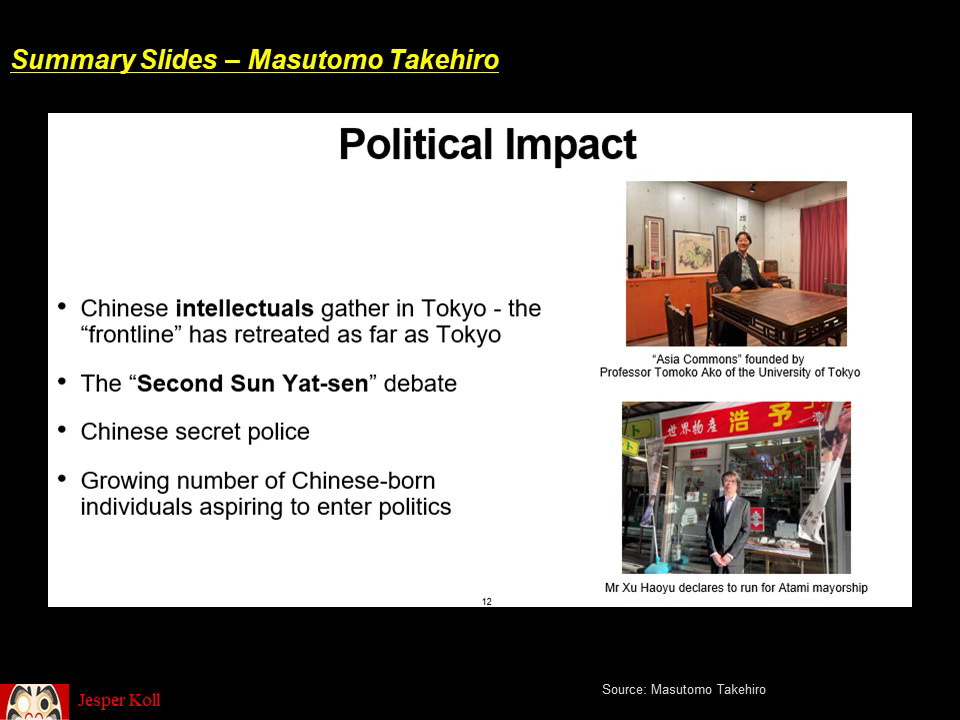


Young Chinese couple in Tokyo - pushing a pram with kids. Young Japanese couple - a pram with little dogs. You know the conclusion.
Fascinating story to be aware of . I find it a bit concerning in truth.